By Emma Glendinning
As a volunteer, I’m one of many in the world. Data from Figure 1—a survey about volunteering among a number of OECD countries—shows that at least one-fifth of the population in many countries engages in volunteer activities.1 Though Figure 1 does not provide details on the amount of time spent volunteering—or indeed if this volunteering is one-off or recurring—we see that volunteering rates in Australia, Canada and the United States stand out for being particularly high, whereas those in Italy, Spain and Sweden are remarkably lower than the OECD average.2
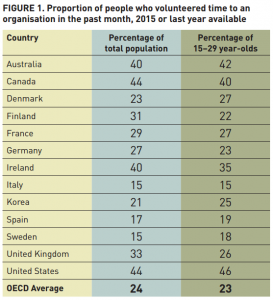
Though Singapore does not feature in this poll, slightly older data (2012) 3 suggests that 32 per cent of its total population volunteered during 2012, with 43 per cent of 15–24 year olds and 28 per cent of 25–34 year olds giving their time to volunteering; 4 both well above the OECD average. The Singapore data also shows an interesting decline in volunteering between the ages of 25 and 34, and this could be due to the life transitions during those years. Whereas until the end of high school or college, youth were required to engage in some hours of volunteering, those of the 25–34 age group are now entering or have entered employment, and thus have fewer opportunities and/or less free time to volunteer. But volunteering trends aside, why is volunteering important and why should youth be involved?
|
MY PERSONAL JOURNEY
Me as a guide leader in 2007 I was seven when I first joined the Girl Guide movement as a Brownie, and through the experience, I grew in confidence, and acquired skills such as teamwork and leadership. My time as a Brownie and then Girl Guide also afforded me the opportunity to participate in numerous activities I wouldn’t have otherwise had the chance or courage to be a part of. At 17, inspired to impart to other girls and young women my skills and knowledge, I embarked on what would become my now 15-year volunteer journey with Girlguiding. Since relocating from the UK to Singapore for work in 2014, I have been helping to run a local Brownie Guide unit. Every week, I work with others to bring a programme of activities to support girls in their emotional, intellectual, moral, social, spiritual and physical development. At least once a year, we take the girls away for a weekend, usually somewhere in Singapore, to enjoy activities, adventure and friendships. Additionally, I have, over the years, taken various roles to support other adult volunteers, assisting with training, administrative support and event organisation for girls and young women aged from 5 to 25. |
In my opinion, it is not enough to document one’s academic abilities alone on a resumé: particularly so with growing numbers of university graduates entering the labour market amid current economic challenges, job competition is stiff. 5 Educational qualifications might tick one requirement box, but for fresh graduates with limited to no work experience, hobbies/interests and extracurricular activities—including volunteer work—will make their CVs stand out from the pile. 6 The key here, however, is the ability of volunteers to recognise and articulate the benefits and impact of such activities. Volunteering need not be life-changing, but is likely to be life-enhancing—and the job applicant who can successfully convince their potential employers that their volunteer experience has equipped them with qualities which are transferable to the working environment will put themselves in a stronger position to clinch the job.
Besides employability, the benefits of volunteering are numerous and well documented. 7 Alongside building confidence, individuals can develop organisational, leadership and teamwork skills in the process, and practise the ability to demonstrate commitment over weeks, months, or even years. In my experience, volunteering with the Girl Guides has enabled me to venture out of my comfort zone, whether it involves visiting unfamiliar, overseas locations, or being responsible for large-scale events.
As a part of this global organisation, I’ve also witnessed how social barriers are broken down when people of all ages and backgrounds are united for a common purpose: for instance, it is not unusual to see 18-year-old Girlguiding volunteers working alongside experienced 60 year olds, each learning skills and knowledge from the other. At the end of the day, it is not their jobs, educational qualifications or household income that bind the volunteers, but the organisation’s mission, identity and values.
Increasingly, educational institutions around the world are appreciating the importance of exposing youth to volunteer work, and are therefore setting “volunteer/service hours” requirements to complement their academic training. For example, all highschool students in Ontario, Canada have to complete 40 hours of service in order to graduate.8 Similarly, highschool students of Maryland, USA are to fulfil 75 hours of service before graduation,9 while some schools in other American states offer credits towards graduation to students completing a certain number of hours of volunteer service.10
In Singapore, students, too, have to participate in a mandatory Community Involvement Programme (CIP), during which they are to clock a minimum of six hours every year throughout their primary and secondary school education. 11 Moreover, the International Baccalaureate Diploma programme includes a compulsory element covering Creativity, Activity and Service (CAS) that calls for its 16–19 year-old students, as part of the “service” element, to complete unpaid and voluntary service, in order to develop civic responsibility, an ethic of service, and grow in selfconfidence and maturity.12
Thanks to these educational institutions, more youth are exposed to a vast array of social causes they could give their time to, and in some cases, ignite in them a passion for volunteerism. Such “outside the-classroom” learning undoubtedly makes them more aware of the impact that their actions can have on their wider community. By developing social consciousness from a young age, I believe individuals can begin to explore their life priorities and set goals based on these unique experiences.

|
Bernice Yau joined SMU Pendeza, a commuity service project that works with a girl's home in Kenya. Bernice Yau, 22, is a final-year law undergraduate at the Singapore Management University (SMU). In addition to her academic requirements, SMU necessitates her to complete 80 hours of service before she can graduate. In her freshman year, Bernice joined SMU Pendeza,13 a community service project that works with a girls’ home in Kenya to provide education and skills programmes. She is one of a handful of students who continued to volunteer time to the service project in subsequent years. In her second year of involvement with SMU Pendeza, Bernice took on the position of Operations Head. Her ability to build rapport with the locals in Kenya facilitated the successful implementation of new initiatives that were developed with her Kenyan friends. Bernice continued as a mentor in her third year, clocking many hours of service beyond the 80 required by the university. Bernice considers SMU Pendeza to be a safe platform in which she could grow and learn, especially since the project is part of her university. Through this experience, she was able to engage with a different side of society, and now sees herself not just as a citizen of Singapore, but that of the world. She’s now equally keen to impart her knowledge to others as she is to learn from those around her. Her service in Kenya has also broadened her focus beyond just grades and prospective employment: she has come to develop a deeper appreciation for her family, friends and the value in serving others. Upon graduation, Bernice wishes to work for an international NGO where she can apply her strengths and skills gained from SMU Pendeza to embark on a career in service work. |
However, in all of these school programmes, the term “service” is used rather than “volunteering”; it can be said that those who have given their time without financial reward have given it for free; however, the compulsory component to schools’ “service” programmes also means students may not have necessarily freely given their time. Some youth who are already involved in numerous extra-curricular activities, or who work parttime/weekend jobs (for financial independence, or to supplement their family income) simply cannot afford the long-term commitment of volunteering.14
As such, organisations may find themselves having to repeatedly train new batches of young volunteers because some cannot give of additional time beyond the mandatory requirements. In fact, according to research, the act of enforcing volunteerism may actually cause long-term volunteer rates to decrease: it showed that youth who considered themselves unlikely to volunteer but who were required to do so had less intention to continue volunteering after completing their stipulated hours.15 This was in contrast to their peers who also thought themselves unlikely to volunteer initially, but who had a stronger intention to continue volunteering after freely giving their time to service.16 Another study revealed that the students who benefitted the least from Ontario’s compulsory service were those who only completed the required number of service hours in order to graduate.17
Of course, the kinds of service opportunities provided to these youth make a difference in how much they take away from the experience. Good-quality, service-learning projects—whereby students are taught at school about social issues, and then take up a relevant service project to gain further knowledge in a real-world situation18—can have more relevance and applicability compared to ad-hoc volunteer placements. Perhaps if young people can see volunteerism as a “journey” towards acquiring life skills and building community awareness, instead of an enforced obligation, it would feel less like a duty and be a more empowering experience. On that point, I believe it is more effective to “incentivise” youth to “service” rather than to mandate it, so as to promote longer-term and more meaningful volunteering. For instance, in many districts in America,19 credits are offered to students who complete volunteer hours, though it is not compulsory to do so in order to graduate.
In addition, some youth organisations offer awards that incorporate volunteering-based clauses—such as the Duke of Edinburgh’s Award in the UK20— to allow the youth working towards these accolades to acquire many life skills and experiences in the process. Consequentially, these awards also speak volumes on college, university and job applications. In 2014, the Singapore government established the Youth Corps Singapore. This organisation, targeted at 16 to 35 year olds, aims to provide “meaningful community service”, to “ignite transformation in society” through “catalysing collaboration between youth, community service organisations and society”.21 With the Youth Corps, young Singaporeans can—through participation in ad-hoc or regular volunteering, leadership programmes and overseas expeditions—recognise that they are not passive citizens, but instead be empowered to work with like-minded youths to make a positive difference in their community.
By giving youth a voice and an active role to play in improving the world around them, I trust that they are much more likely to develop a passion for volunteerism, because it will stem from a deeper desire to engage with others and to contribute towards making a meaningful impact on society.
|
Lucy Traves completed 6 months of service as part of the requirements for the Duke of Edinburgh's Award. At the age of 16, Lucy Traves embarked on her Duke of Edinburgh’s Award, which required her to complete six months of service. She chose to volunteer with Girlguiding,22 the UK’s largest girls-only youth organisation. Lucy was nervous to step into this service role, so she chose an organisation that she already had knowledge of and therefore felt comfortable joining. Five years later and now aged 21, Lucy’s role has grown beyond that of an ordinary “helper”. Presently in charge of a group of 7 to 10 year olds, she holds weekly meetings and handles all administration, including the annual accounts, for the group. Lucy shared that volunteering has helped her grow in confidence and overcome her fear of public speaking. Running a village youth group has also enforced her sense of belonging within her local community: when out for walks, shopping or a meal, Lucy often bumps into someone who knows her due to her volunteering, and a friendly chat usually follows. |
In essence, youth volunteerism comes down to the quality of engagement. Whether it is tending a community garden, coaching at a local sports’ club, providing tuition to those unable to afford it, fundraising for a charity, or serving food to people who are homeless, if volunteers understand their part in the community and the impact of their service, then their introduction to volunteering at a young age will probably continue to impact on them throughout life. School “service” programmes, mandatory or not, give youth a good headstart in terms of understanding their wider community, issues within it, and how each person can make some kind of difference. Although not all students go on to volunteer throughout their lives, those introduced to service from their youth are all the more likely to appreciate their potential to make a positive impact on their community and develop a sense of social responsibility 23 —qualities that are greatly valued both at the workplace and in society.
Notes
1 “The Organisation for Economic Co-operation and Development (OECD) (French: Organisation de coopération et de développement économiques, OCDE) is an international economic organisation of 34 countries founded in 1961 to stimulate economic progress and world trade.” Taken from https://en.wikipedia.org/wiki/Organisation_for_Economic_Co-operation_and_Development
2 “The OECD average, sometimes also referred to as the country average, is the mean of the data values for all OECD countries for which data are available or can be estimated. The OECD average can be used to see how a country compares on a given indicator with a typical OECD country.” Definition from https://www.oecd.org/edu/school/programmeforinternationalstudentassessmentpisa/35002965.pdf
3 Ministry of Culture, Community and Youth, “Publications & Statistics—Community”, MCCY website, 14 February 2014, at https://www.mccy.gov.sg/en/Publications_Statistics/Community.aspx
4 Ministry of Culture, Community and Youth, “Publications & Statistics—Youth”, MCCY website, 14 February 2014, https://www.mccy.gov.sg/en/Publications_Statistics/Youth.aspx
5 Niall McCarthy, “Which Countries Have the Most Unemployed Graduates? [Infographic]”, Forbes, 13 October 2015, at http://www.forbes.com/sites/niallmccarthy/2015/10/13/whichcountries-have-the-most-unemployed-graduates-infographic/#d25ab4fdd216; Ng Jing Ying, “As Graduate Numbers Grow, a Hard Truth: Not All Degrees Are Equal”, TODAY, 23 May 2015, at http://www.channelnewsasia.com/news/singapore/as-graduate-numbersgrow/1866808.html
6 Anne Fisher, “Here’s Why You Should Put Volunteer Work on Your Resume”, Fortune, 29 June 2016, at http://fortune.com/2016/06/28/volunteer-work-resume
7 Rita Altman, “The Benefits of Volunteering”, Huffington Post, 5 June 2013, at http://www.huffingtonpost.com/rita-altman-rn/the-benefits-of-volunteer_b_3377383.html
8 Paulette Padanyi, Mark Baetz, Steven D. Brown and Ailsa Henderson, “Does Required Volunteering Work? Results from Ontario’s High School Community Service Program”, Social Economy Fact Sheet #23 (Spring 2009), at http://socialeconomycentre.ca/PDF/factsheets/requiredvolunteering.pdf
9 Education Commission of the States, “High School Graduation Requirement or Credit toward Graduation—Service-Learning/Community Service”, ECS website, January 2014, at http://ecs.force.com/mbdata/mbquest3RTE?Rep=SL1301
10 Ibid.
11 National Library Board, “Launch of Community Involvement Programme 1st October 1997”, HistorySG: An online resource guide, 2014, at http://eresources.nlb.gov.sg/history/events/c78526c6-decf-4b79-b4ca-421739464884
12 International Baccalaureate Organization, “Community Service”, IBO website, at http://www.ibo.org/programmes/diploma-programme/what-is-the-dp/community-service
13 For more information on SMU Pendeza, see http://www.smupendeza.com
14 Lily Lou, “Op-ed: The Downside of School Volunteer Requirements”, The Prospect, 28 February 2015, at http://www.theprospect.net/op-ed-the-downside-of-school-volunteerrequirements-38685
15 Sarah D. Sparks, “Community Service Requirements Seen to Reduce Volunteering”, Education Week, 20 August 2013, at http://www.edweek.org/ew/articles/2013/08/21/01volunteer_ep.h33.html; Arthur Stukas, Mark Snyder and E. G. Clary, “The Effects of ‘Mandatory Volunteerism’ on Intentions to Volunteer”, Psychological Science 10, 1 (1999): 59–64, at https://www.researchgate.net/publication/247781198_The_Effects_of_Mandatory_Volunteerism_on_Intentions_to_Volunteer
16 Ibid.
17 Padanyi, Baetz, Brown and Henderson, “Does Required Volunteering Work?”.
18 A. Lisa Fahrenthold, “Family Volunteering and Youth Engagement in the Non-Profit Sector: An Analysis of Benefits”, Serviceleader.org, December 2003, at https://www.serviceleader.org/volunteers/familyvolunteering
19 Education Commission of the States, “High School Graduation Requirement or Credit toward Graduation—Service-Learning/Community Service”.
20 The Duke of Edinburgh's Award homepage, at http://www.dofe.org
21 Youth Corps Singapore, “Who We Are”, Youth Corps Singapore website, at https://www.youthcorps.sg/AboutUs
22 For more information, visit http://girlguiding.org.uk 23 Online College, “12 Reasons Community Service Should Be Required in Schools”, OnlineCollege.org, 27 June 2012, at http://www.onlinecollege.org/2012/06/27/12-reasonscommunity-service-should-be-required-schools
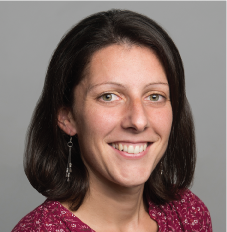 |
Emma Glendinning was Research Fellow at the Lien Centre for Social Innovation. Her research interest lies in community development, and she conducted research into food needs in Singapore. Emma previously worked for local Government in the UK before moving to Singapore in 2014. She holds a PhD from Cardiff University, and during her course of study, she explored the communities within UK farmers’ markets. As a volunteer, Emma is both a leader with a Brownie Unit in Singapore as well as a District Commissioner to British Guides in Foreign Countries (BGIFC), Singapore. Connect with her on LinkedIn. |




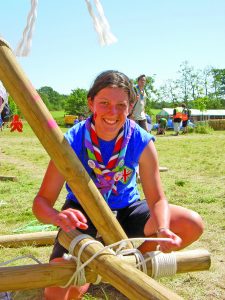
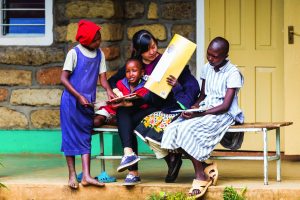
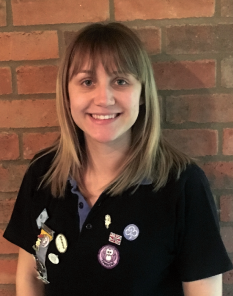
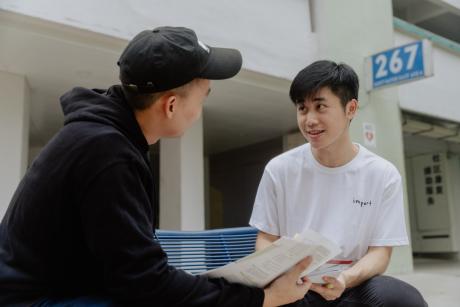



Comments